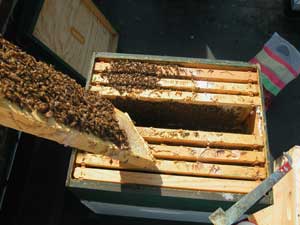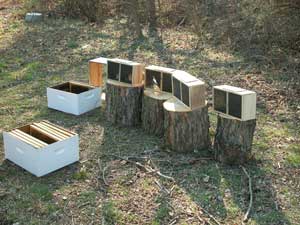 Sorry that it has been a while folks, but as a local apiary inspector told me in a (late) email this week, it's the time of year when beekeepers tend to be digging in beehives, not tickling mice!
Sorry that it has been a while folks, but as a local apiary inspector told me in a (late) email this week, it's the time of year when beekeepers tend to be digging in beehives, not tickling mice!So, you all might be keeping score already, but let me sum up where we landed in March 2007:
- five colonies went into the winter: two on the roof, two at the monastery, and one at the historic mill park;
- one colony, at the historic mill, died. The apiary inspector (mentioned above) has given his opinion — which happened to agree with MaryEllen's and BWrangler's — that they dwindled due to mite-vectored disease, and that the frames and all can be reused;
- there was evidence of life in all the remaining hives; but;
- no one had been down inside any living hive since Fall to see the state of the colonies inside.
We returned from travel on March 17 (sometime, perhaps you can ask about the charm of being in Newark Airport during an ice closure, and how you can end up returning from Israel on the train!) By March 25, all four surviving hives had been surveyed (as well as a couple belonging to my friend Jane, who was worried about hers). MaryEllen, Doug and I had installed four new packages each at the mill. To clarify, I am a godmother of 6 honeybee families now: 2 on the roof, two at the monastery, two at the mill.
On March 20, the roof bees were simply marvelous. The year had truly begun, with both queens laying and abundant new brood. The picture above shows nurses covering new brood (no close ups, sorry: the camera ran out of gas). It seems that my constant desire to feed them left them very well stocked for the Spring, too: there was almost a medium super's worth of honey throughout each hive. I saw no bees with deformed wings, and lots of bees flying in and out. * Happiness *
 On March 25, we did a simple thing that should not be overrated: we installed 4 packages of bees! Jane (another club member, who worries way too much about how she handles her bees) came along to help and to get more experience. Watch the sidebar for a detailed run-down of how we did it: I messed up a lot less than I did two years ago! My girls went onto drawn comb left by the deceased colony: this should help them get a much quicker start because the queen can begin to lay right away, and there is already honey in the hive for nurses to feed the young. MaryEllen checked a couple of days later, and said it all looked like a living apiary again. I will name one of the hives "Cockrill" again (hey, no superstition here) but am currently stumped for the other hive's name. I'm thinking about perhaps the current miller on the site...
On March 25, we did a simple thing that should not be overrated: we installed 4 packages of bees! Jane (another club member, who worries way too much about how she handles her bees) came along to help and to get more experience. Watch the sidebar for a detailed run-down of how we did it: I messed up a lot less than I did two years ago! My girls went onto drawn comb left by the deceased colony: this should help them get a much quicker start because the queen can begin to lay right away, and there is already honey in the hive for nurses to feed the young. MaryEllen checked a couple of days later, and said it all looked like a living apiary again. I will name one of the hives "Cockrill" again (hey, no superstition here) but am currently stumped for the other hive's name. I'm thinking about perhaps the current miller on the site...The question at the monastery was more complicated. Both colonies were still there, but something had gone wrong with the queens. Both were laying only drones, which means that the queens had either run out of sperm or that their reproductive organs were not functioning right, and the colonies were going to collapse if a fertile queen were not introduces soon. But there were no queens to be bought, and Larry, the most experienced beekeeper I know, said I would be lucky to find queens by April.
While I was in the MaryEllen hive, I even saw the failed queen: she looked fat and beautiful, but she was not the marked beauty that was there in the Fall. Her daughters may have superceded here due to some hardship during this weird winter. If so, she did not mate. Could this have happened to BOTH hives? Larry said it was truly strange. Could it be an affect of the oxalic treatment in the fall? The roof bees got the same, and came back strong. Oh mysteries, and second guessing, and so little to do about it anyway.
But, as usual, I was saved by MaryEllen. She had ordered (WAY ahead of anyone else) queens for spring requeening of her hives, and she still had two left. And said I could have them, if I replaced them when queens became available.
Like before, I found the queen of the MaryEllen hive right away, and (quite terribly) had to kill her. I hesitated to do it, and set her aside in a box, but when I turned back to her, she was trying pathetically to climb back home. So then I did her in, and buried her near her hive. There is something heartwrenching about this task of killing a helpless being, who bore no fault for her state. Yet a healthy colony would do the same to one of its own. This is little comfort, and maybe comfort should not be had.
I placed the new queen, who came in a plastic cage that was way odd to me, and the girls freed her in three days. I will be visiting this week to see how she is doing. She has a yellow dot, and I am trying to work out a saintly name for her. Suggestions welcome!
The Doug colony was hard, hard, hard by comparison. The first time I went in there (and discovered all the drone brood) I had dropped a frame, and throughout that visit — and the next two! — I failed to find the queen, looking at each side of each frame, going in and going out. I began to freak, since I needed to be sure that there was no queen if those girls would ever accept a new one, but I had no way to make certain of the fact!
MaryEllen rescued me again. She suggested that I make a little nuc in a super with my new queen (still caged) and some bees and frames from one of my strong roof hives. They would free the queen, she would lay down her fertile-mamma mojo, and MaryEllen and I would visit on the next good day to see if we could find a queen below, and if not, to unite the two groups. She is quite the smarty, that one.
Of course, the weather has turned cold again, so I probably cannot get in again until Monday (5 days from now, and 12 since my last visit: much longer than planned) but I have hope for both colonies.
And more news: at least one other beekeeper will be joining me at the monastery, a direct result of the girls' presence there this year. Let us all praise Spring, the renewal of life and friendships, and time in the sun for people and bees!
6 comments:
The use of Pesticides and genetically modified plants are making the drones unable to produce viable sperm.
I realize that the world is having a major problem with the demise of the Bee population. The ANSWER to this PROBLEM is: GROW MINT PLANTS NEAR THE CROPS. Mint pollen has a natural enzyme that KILLS the Varroa jacobsoni mite. It is transferred on the bee fur and carried back to the hives and inoculates the rest of the hive. I have been doing this for 18 years, and every year the Bees return to partake of the mint flowers and pollenate our fruit trees.
Sincerely, Aunt Susan
Are you willing to get new bees? I have two fresh swarms in a hand reach areas. I'm searching for a beekeeper who is willing to take care of them after the removal, not killing them. Those are lots of bees!
Hey Ralph --
If you send me an email, or drop me a comment telling me where you are (I won't publish your detail if you don't want me to) I bet I can find a beekeeper for your bees. You are probably nowhere near me, as swarms are not very likely around here yet!
Cheers,
Toni
Hi, I've been an avid reader of your blog for the past year or so and it has in fact inspired me to create my own. If you're interested I'd appreciate it if you would go check it out at www.topbarhiveblog.com.
It's still pretty rough around the edges since I haven't had time to play with the wordpress themes or anything, but I'm hoping that it will evolve into something worth reading. Thanks.
Spring has finally come to my own bee yard - not urban, not USA, but still "bumpy" as beekeeping tends to be these days... Never mind, the sun is out at last, and the bees are flying, bringing in the very first pollen from the early-blooming alders long before the snow is gone.
It's a pleasure to have come across your blog, and to read some of your beekeeping adventures.
More power to you - and my very best wishes for your queens!
Jen
(in Atlantic Canada)
thanks admin
information is the most beautiful treasures
Post a Comment